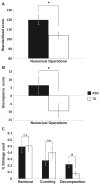Brain organization underlying superior mathematical abilities in children with autism
- PMID: 23954299
- PMCID: PMC3897253
- DOI: 10.1016/j.biopsych.2013.06.018
Brain organization underlying superior mathematical abilities in children with autism
Abstract
Background: Autism spectrum disorder (ASD) is a neurodevelopmental disorder characterized by social and communication deficits. While such deficits have been the focus of most research, recent evidence suggests that individuals with ASD may exhibit cognitive strengths in domains such as mathematics.
Methods: Cognitive assessments and functional brain imaging were used to investigate mathematical abilities in 18 children with ASD and 18 age-, gender-, and IQ-matched typically developing (TD) children. Multivariate classification and regression analyses were used to investigate whether brain activity patterns during numerical problem solving were significantly different between the groups and predictive of individual mathematical abilities.
Results: Children with ASD showed better numerical problem solving abilities and relied on sophisticated decomposition strategies for single-digit addition problems more frequently than TD peers. Although children with ASD engaged similar brain areas as TD children, they showed different multivariate activation patterns related to arithmetic problem complexity in ventral temporal-occipital cortex, posterior parietal cortex, and medial temporal lobe. Furthermore, multivariate activation patterns in ventral temporal-occipital cortical areas typically associated with face processing predicted individual numerical problem solving abilities in children with ASD but not in TD children.
Conclusions: Our study suggests that superior mathematical information processing in children with ASD is characterized by a unique pattern of brain organization and that cortical regions typically involved in perceptual expertise may be utilized in novel ways in ASD. Our findings of enhanced cognitive and neural resources for mathematics have critical implications for educational, professional, and social outcomes for individuals with this lifelong disorder.
Keywords: Autism; brain organization; cognitive strengths; mathematical abilities; multivariate pattern analysis; support vector machine.
Copyright © 2014 Society of Biological Psychiatry. Published by Elsevier Inc. All rights reserved.
Conflict of interest statement
The authors report no biomedical financial interests or potential conflicts of interest.
Figures



Similar articles
-
Brain hyper-connectivity and operation-specific deficits during arithmetic problem solving in children with developmental dyscalculia.Dev Sci. 2015 May;18(3):351-72. doi: 10.1111/desc.12216. Epub 2014 Aug 6. Dev Sci. 2015. PMID: 25098903 Free PMC article.
-
Default mode network in childhood autism: posteromedial cortex heterogeneity and relationship with social deficits.Biol Psychiatry. 2013 Aug 1;74(3):212-9. doi: 10.1016/j.biopsych.2012.12.013. Epub 2013 Jan 31. Biol Psychiatry. 2013. PMID: 23375976 Free PMC article.
-
Clinical and Cognitive Characteristics Associated with Mathematics Problem Solving in Adolescents with Autism Spectrum Disorder.Autism Res. 2016 Apr;9(4):480-90. doi: 10.1002/aur.1524. Epub 2015 Sep 29. Autism Res. 2016. PMID: 26418313 Free PMC article.
-
Functional magnetic resonance imaging of autism spectrum disorders.Dialogues Clin Neurosci. 2012 Sep;14(3):319-51. doi: 10.31887/DCNS.2012.14.3/gdichter. Dialogues Clin Neurosci. 2012. PMID: 23226956 Free PMC article. Review.
-
Arithmetic in the developing brain: A review of brain imaging studies.Dev Cogn Neurosci. 2018 Apr;30:265-279. doi: 10.1016/j.dcn.2017.05.002. Epub 2017 May 17. Dev Cogn Neurosci. 2018. PMID: 28566139 Free PMC article. Review.
Cited by
-
Autism and Beauty: Neural Correlates of Aesthetic Experiences in Autism Spectrum Disorder.Soa Chongsonyon Chongsin Uihak. 2018 Jul 1;29(3):101-113. doi: 10.5765/jkacap.170031. Soa Chongsonyon Chongsin Uihak. 2018. PMID: 32595302 Free PMC article.
-
Imaging Pain.Anesthesiol Clin. 2016 Jun;34(2):255-69. doi: 10.1016/j.anclin.2016.01.001. Anesthesiol Clin. 2016. PMID: 27208709 Free PMC article. Review.
-
Linear and nonlinear profiles of weak behavioral and neural differentiation between numerical operations in children with math learning difficulties.Neuropsychologia. 2021 Sep 17;160:107977. doi: 10.1016/j.neuropsychologia.2021.107977. Epub 2021 Jul 28. Neuropsychologia. 2021. PMID: 34329664 Free PMC article.
-
Brain structure underlying the empathizing-systemizing difference in children with autism spectrum disorder.World J Pediatr. 2023 Aug;19(8):782-792. doi: 10.1007/s12519-023-00732-8. Epub 2023 Jun 5. World J Pediatr. 2023. PMID: 37273174
-
Polygenic risk for ADHD and ASD and their relation with cognitive measures in school children.Psychol Med. 2022 May;52(7):1356-1364. doi: 10.1017/S0033291720003189. Epub 2020 Sep 14. Psychol Med. 2022. PMID: 32924895 Free PMC article.
References
-
- Autism and Developmental Disabilities Monitoring Network Surveillance Year. Principal Investigators; Centers for Disease Control and Prevention (2012) Prevalence of autism spectrum disorders–Autism and Developmental Disabilities Monitoring Network, 14 sites, United States, 2008. MMWR Surveill Summ. 2008;61:1–19. - PubMed
-
- Volkmar FR, Lord C, Bailey A, Schultz RT, Klin A. Autism and pervasive developmental disorders. J Child Psychol Psychiatry. 2004;45:135–170. - PubMed
-
- Baron-Cohen S, Belmonte MK. Autism: A window onto the development of the social and the analytic brain. Annu Rev Neurosci. 2005;28:109–126. - PubMed
-
- Happè F, Frith U. Autism and Talent. New York: Oxford University Press; 2010.
-
- Sacks OW. The Man Who Mistook His Wife for a Hat. South Yarmouth, MA: J. Curley & Associates; 1986. - PubMed
Publication types
MeSH terms
Substances
Grants and funding
LinkOut - more resources
Full Text Sources
Other Literature Sources

